


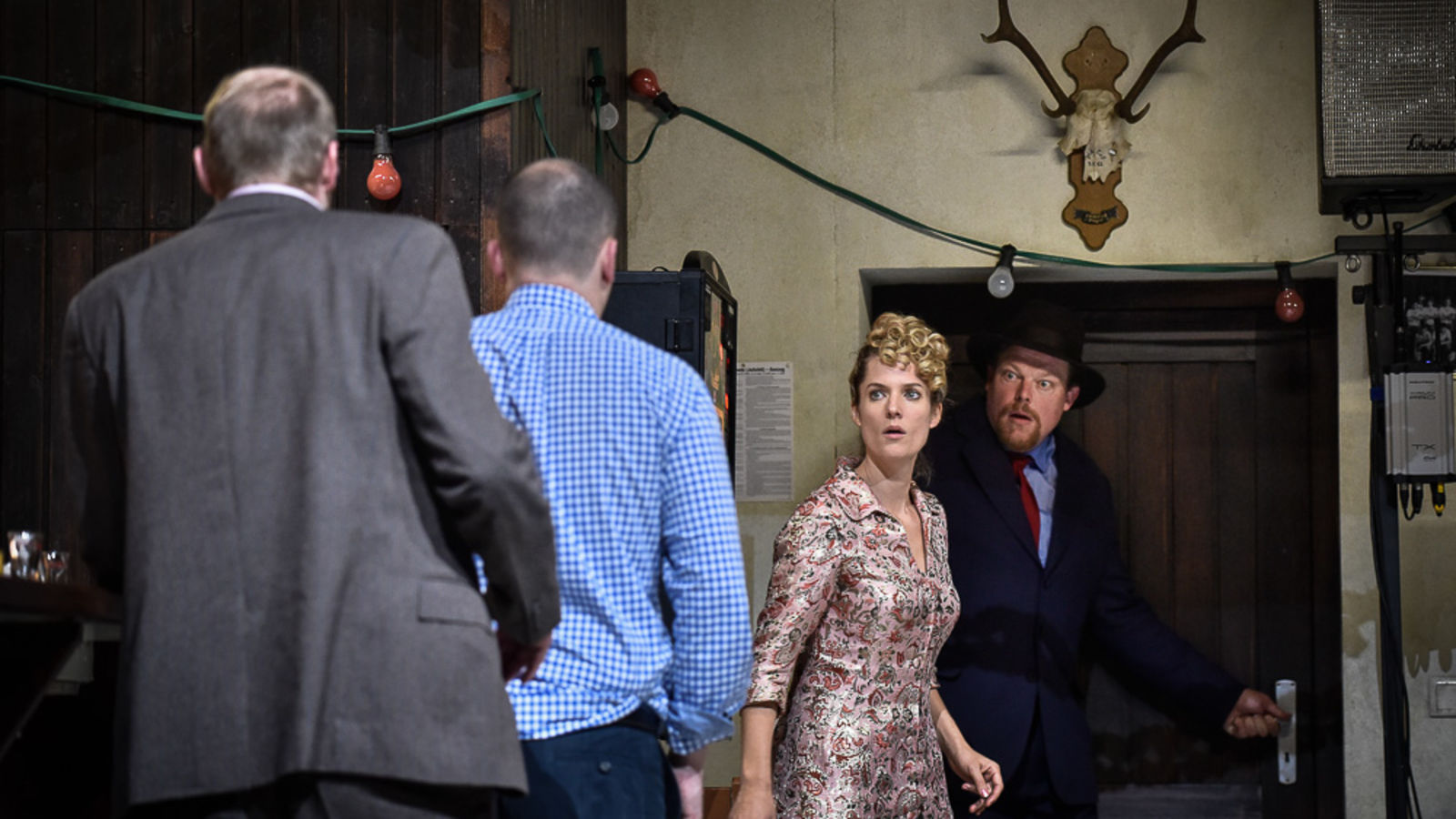
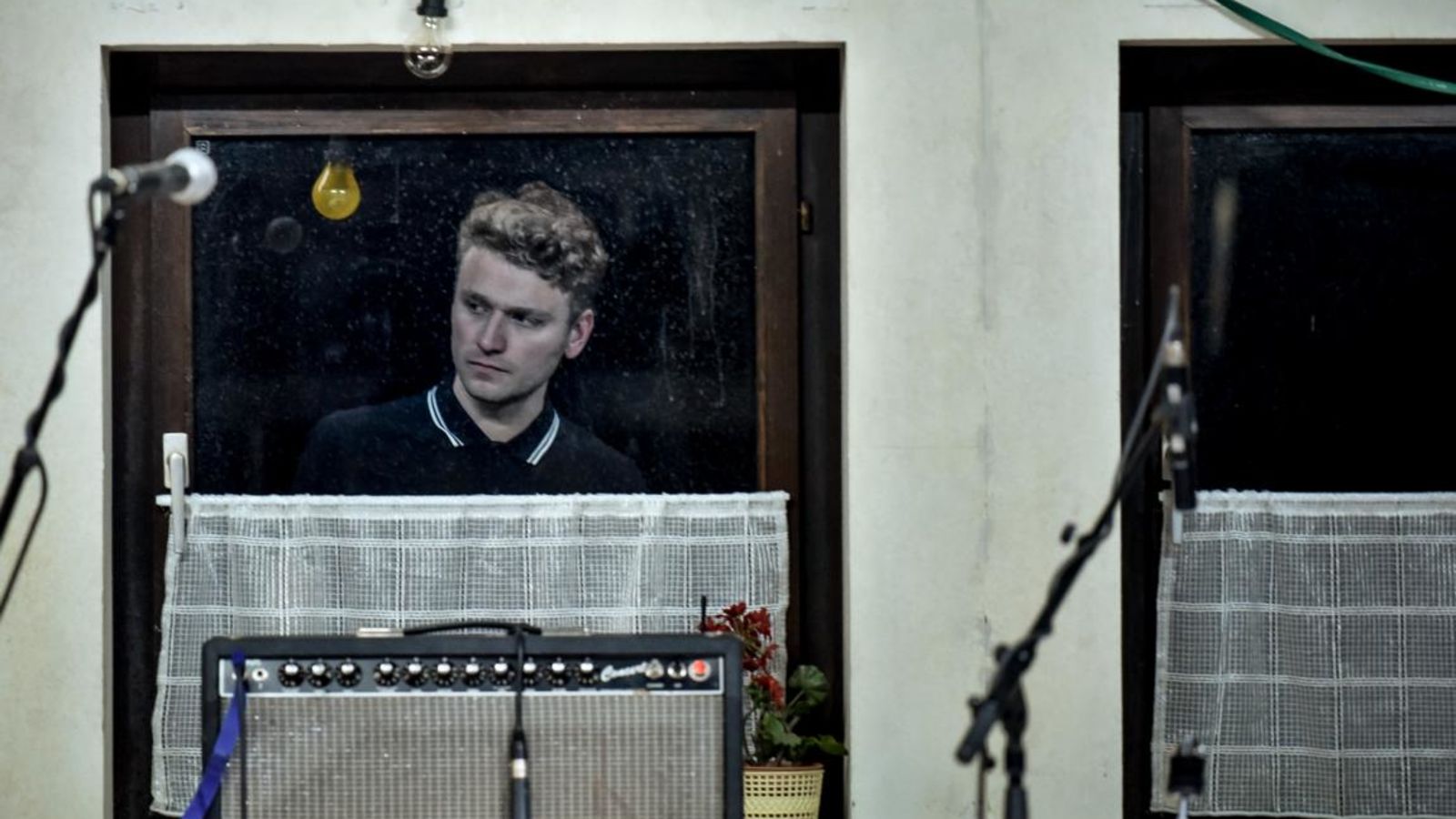
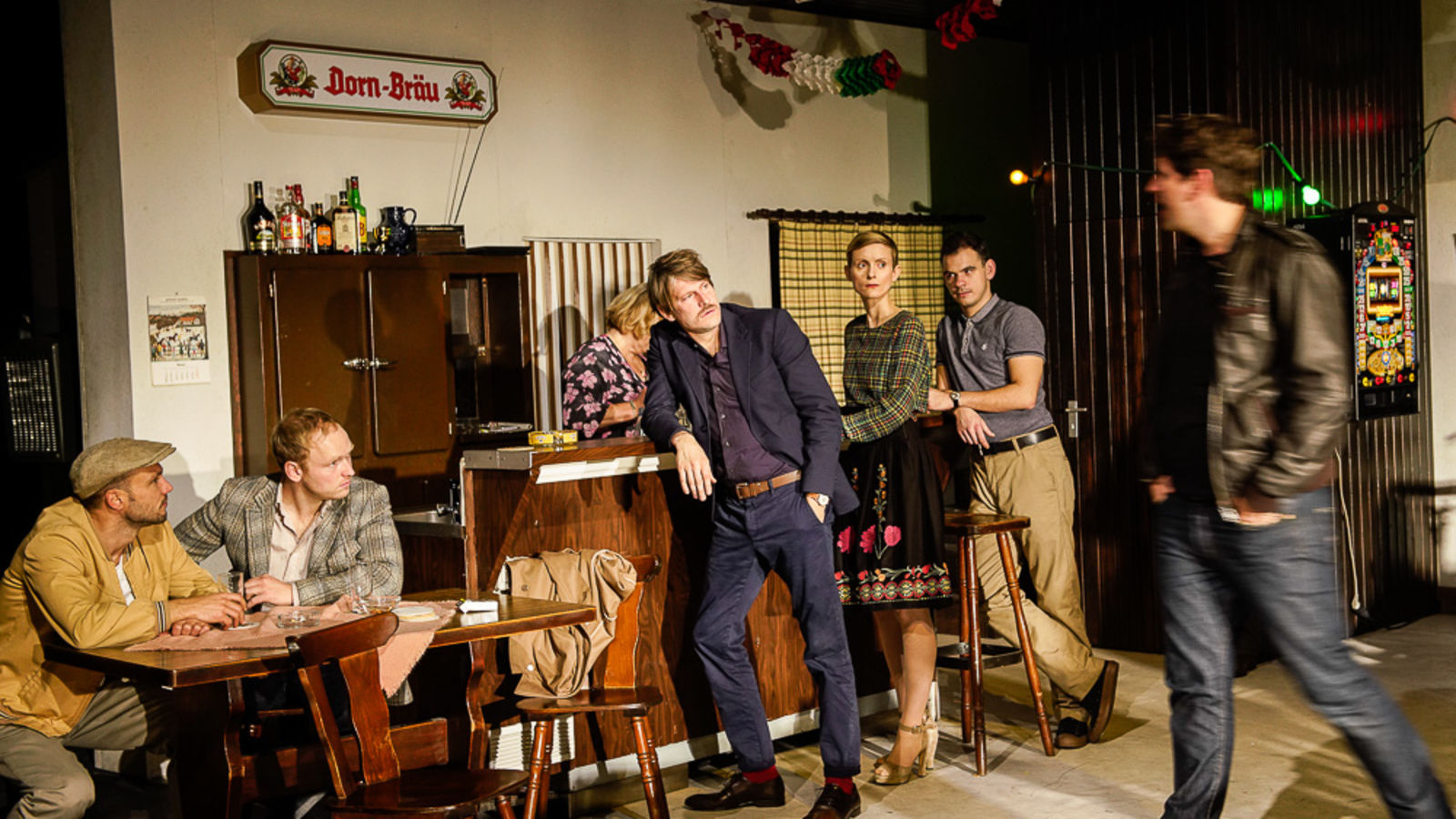

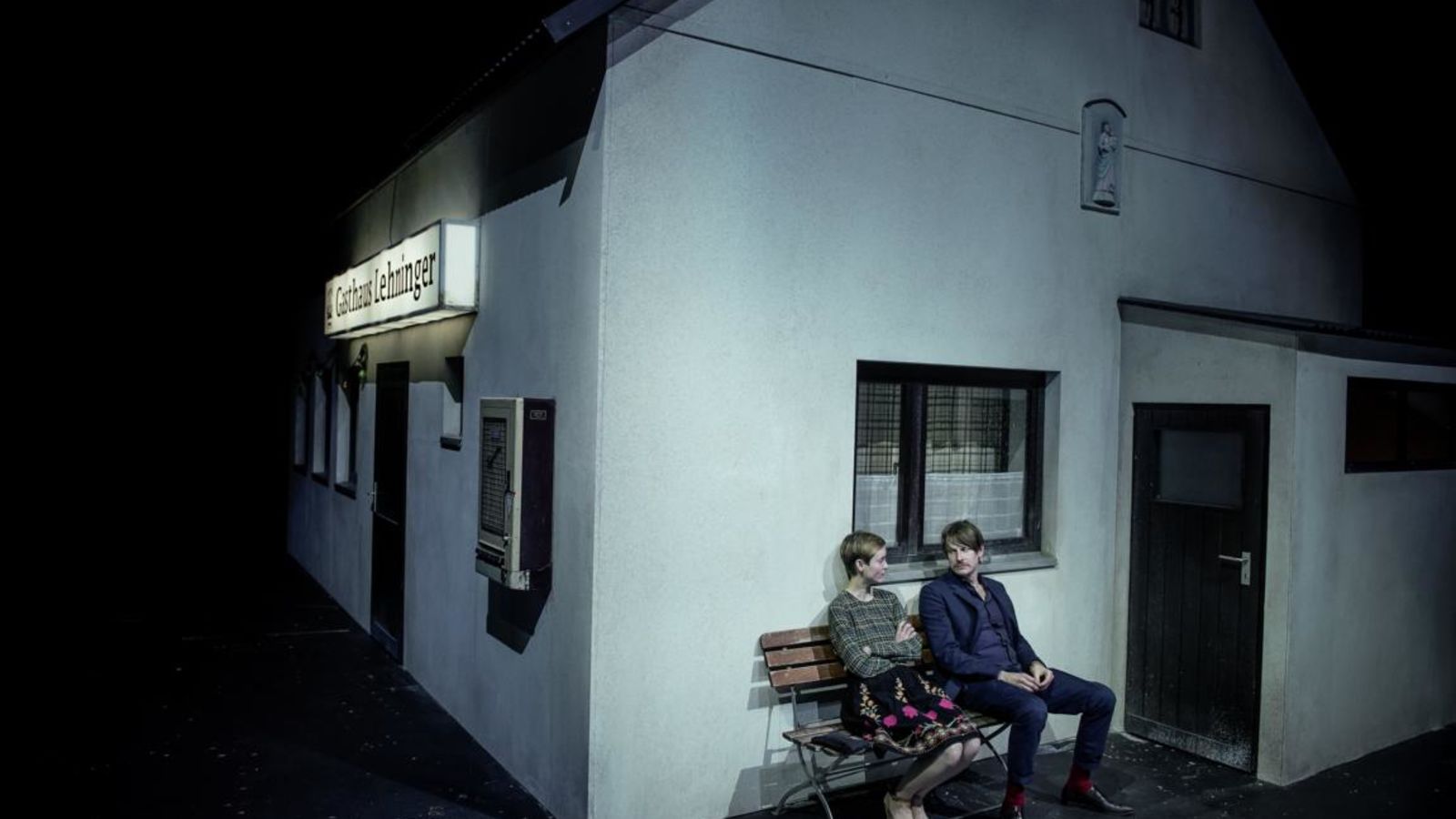







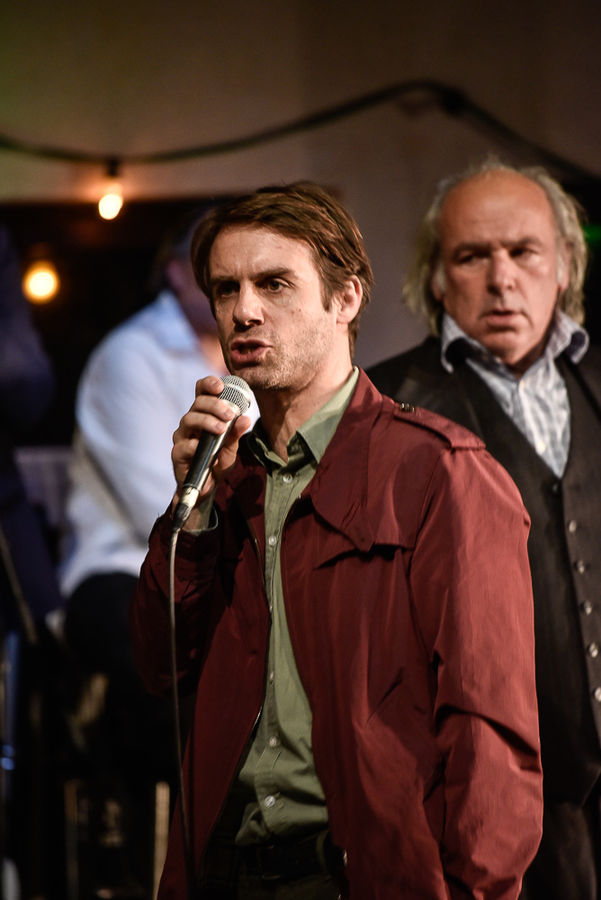
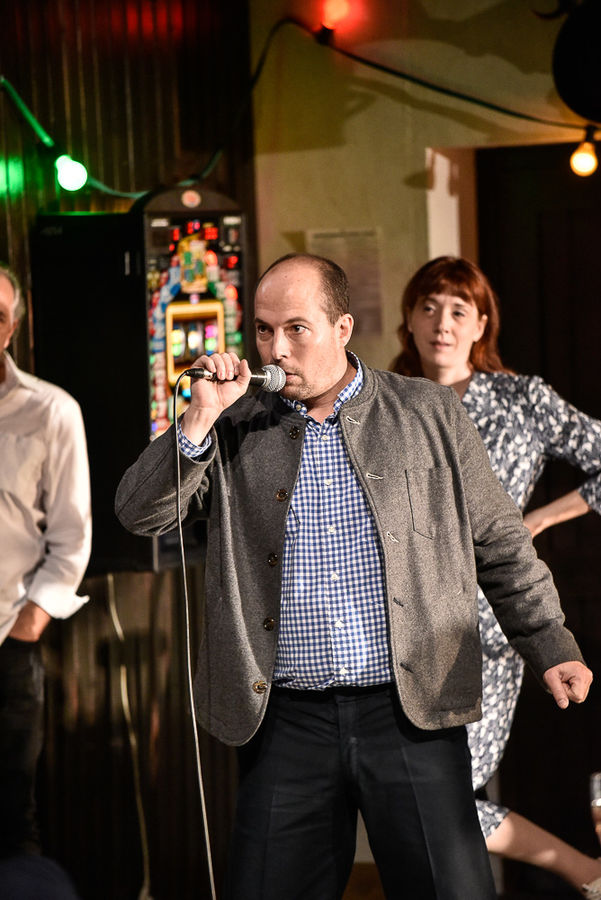
Looking for the Future: Ostermeier’s »Italian Night«
by Joseph Pearson
13 November 2018
I’m looking at a series of photographs, taken on a research trip to Lower Bavaria by director Thomas Ostermeier and his set designer Nina Wetzel. Ostermeier grew up in this region. He points out chalky, plain, and water-stained facades, dark peaked rooves. Many of the interiors of these country pubs are derelict, with broken furniture. »The Gasthaus is dying all over Bavaria because the new generation is not taking over«, he tells me, »Look here – « In another photo, a barmaid opens a window that allows her to sell beer directly to the street. But it doesn’t look like this innovation is used now very often. A ghostly feeling comes from the tavern’s interior, with its many unoccupied places that were once for merriment.
The towns where these pubs are located might at first glance appear to be at the edge of political life, but with the rise of right-wing politics, they are increasingly at the centre of national interest. When I see pictures of these abandoned and underused spaces, I can’t help but think about the perceptions and realities that buoy the Alternative for Germany: economic inequality, a lack of experiences with people from different backgrounds, and the feeling of having been left behind. In the October 2018 elections, the AfD was the second most popular party (after the CSU) in every riding in Lower Bavaria, with almost 30% support in some localities. The playwright Ödön von Horváth appreciated how political life in the provinces impacts the centre in his Volksstücke. The small town becomes a laboratory of political conflicts – most notably in his 1931 play, »Italian Night«. In it, a town’s left-wingers cannot organise themselves to face the fascist threat.
I enter the practice stage of the Schaubühne and am surprised to see this provincial world materialise before me. We are in the fifth scene of Horváth’s play, in a pub, modelled after the photographs Ostermeier took. I see a long illuminated sign, reading »Gasthaus Pichlmeier«. An ancient cigarette machine is stuck to the white rustic façade. A pool of urine has collected at its base. Characters look through windows. Conversations are overheard. Then the set suddenly revolves, and we enter a well-worn interior – that could be from today or fifty years ago – decorated with Italian colours, streamers, a string of lights recycled from Christmas. A small-town band, »The Riccardos«, play a trumpet, guitar and synthesiser. Songs amplify like »It’s Now or Never« or Germanised takes on Italian pop tracks – songs that »almost made it«, Ostermeier tells me. The patrons, meanwhile, sit on dark wooden chairs, at tables with bevelled edges and artificial flowers, gripping their Steins. A gang of Communists slouch in padded jackets, posing with wide stances, smoking, with the projected machoism of the powerless. Perhaps they are recovering from a pub fight, or anticipating the next political catastrophe.
Horváth’s play originally contained a series of »pictures« of country life (each one constituted a scene of the play). But under Ostermeier’s direction, we have instead continuous action that feels more like a film. It’s taken as if in one shot, through the modular revolving set, inside and outside a pub without scene changes. The whole effect of the mise-en-scene is frieze-like – Felliniesque, or perhaps from Visconti – and I’m impressed how space on stage is used by large numbers of actors without it ever feeling messy.
Thomas Ostermeier, sitting in a swivel chair facing the stage, turns around to me, and I ask whether there will be video in his production. Or if he’s discarded what is often seen as a trademark device. He replies that he wanted a fluent feeling of the events. But he doesn’t use video to achieve this effect. Instead, I notice the »imprint« of film in the production: the movement of the stage creates that effect for us. We can alternate between scenes that create distance, where we are lost in the crowd, and then the stage revolves, and we are given moments of intimacy.
Ostermeier remarks, »I can tell you, it’s a lot harder to achieve this effect this way, without the video«.
Meanwhile, on stage, a Communist raises his voice at the bar – a quote from Horkheimer – »Wer aber vom Kapitalismus nicht reden will, sollte auch vom Faschismus schweigen!«. »If you don’t want to talk about capitalism, then you’d better keep quiet about fascism!«
And suddenly we are deep in politics. The play might be read as a lampooning of the left-wing. The Social Democrats throw parties, the communists are devious and ideological, and the two camps cannot agree on anything, and – in their disunity – are unable to face the rising threat of the fascists, practising with their rifles at the other end of town. The Left loses its appeal to the very workers it is meant to represent.
Ostermeier tells me, »If we had done this play six months ago as planned, it would have been prescient. Now, it is just contemporary.«
Indeed, the production was supposed to premiere last Spring but was delayed due to an illness in the ensemble. Certainly, if we look at the results of the SPD in recent elections in Bavaria and Hessen, one could say the production would have hailed the impotence of the traditional Left (although the Greens have meanwhile emerged as a moderating force). But I don’t think the delay makes Horváth’s play’s contemporary resonance any less striking. The company had to make very few changes to the text to make it reflect today’s political climate (such as when they bring the far-right rhetoric up-to-date by lifting text, for example, from today’s Identitäre movement).
»It’s remarkable how we can still identify with Horváth’s portrait of all the varieties of a social democratic left. He also gives us a play that shows us how these democratic forces can lose the countryside, which becomes more and more infiltrated by the right. The big gap between big cities and rural areas is also strikingly contemporary. That is also the reason why I am doing this play: I appreciate that you see on-stage a reality that we all want to ignore. It’s a world that most of the audience left behind themselves, because most people I know in Berlin come from the provinces but no longer want to be connected to it. It’s like a divided country, where the big cities have forgotten about the rest. This is also in the play. It’s also why I think it will be interesting to put this on the stage in the middle of Berlin, which considers itself so open to the world and so cosmopolitan. I am really curious how it will work here.«
While, there has been a strong tendency – in the press, in cultural production – to connect our current experience to that of the Weimar Republic, the constellation of political problems, of course, cannot be the same in Horváth’s play. As Ostermeier tells me, »It might seem we repeat the same mistakes, but the situation today is of course different. To say the opposite would be banal. What I try to do is provoke, or shock, so we understand where we have been already«. Indeed, »History does not repeat, it rhymes«. The play provides a frame through which to analyse our ability to respond to the right-wing.
I ask Ostermeier whether the play provides us with any solutions to the Left’s divisions, or at least some guidance in negotiating our current political terrain.
He replies, »No, it does not provide us with solutions. Rather, it asks the right questions. But let me ask you: would this be an interesting play if it answered those questions? Again, probably not.«
»So, where do we go from here?« I ask him.
»If you are looking for solutions, then maybe listen to the women characters«, Ostermeier suggests, »Or consider what we need to do to reinvent popular aesthetics on the Left to make them truly counter-culture, so they can capture young people’s attention. Or consider what happened during the Unteilbar demonstration in Berlin some weeks ago. People from a wide political spectrum were able to come together and work together. You need a broad message – such as redistribution of income and wealth, anti-racism, respect for diversity – to create solidarity that goes beyond the kind of hair-splitting of issues that is common on the Left«.
The stage revolves once more. Perhaps, we are swept up in the movement. Thomas tells me that »the set is just a little bit scary, like a haunted house«. And as I watch its spectral movements, I wonder what this play might tell us about German politics in the coming six months, and whether it might again be prescient in unexpected ways. Perhaps, we will be terrified.
*
À propos, the future is also the subject of a conference on the topic at the Schaubühne on the 25th of November, entitled: »Which Left do we want?«
Italian Night
by Ödön von Horváth
in a version by Thomas Ostermeier and Florian Borchmeyer
Direction: Thomas Ostermeier
Premiered on 23 November 2018
Mit dem Aufruf des Videos erklären Sie sich einverstanden, dass Ihre Daten an YouTube übermittelt werden. Mehr dazu finden Sie in unserer Datenschutzerklärung.
Bei Klick auf die Schaltfläche "Akzeptieren" wird ein Cookie auf Ihrem Computer abgelegt, so dass Sie für die Dauer einer Stunde, diese Meldung nicht mehr angezeigt bekommen.
Pearson’s Preview

Archive
December 2017
Hallelujah Neuruppin! »fontane.200« at the Schaubühne
October 2017
Creative Unrest: Milo Rau’s »LENIN«
| Page 5 of 10 pages |
